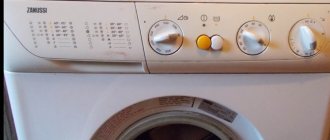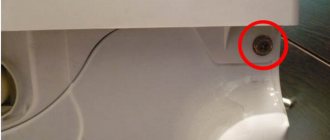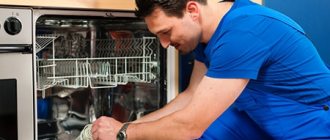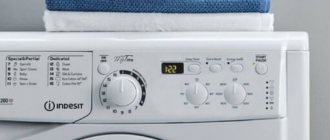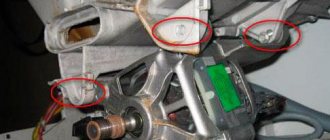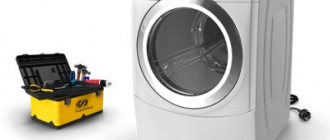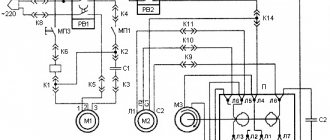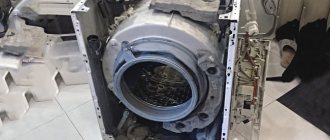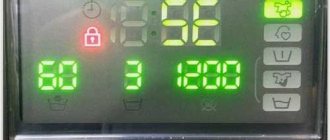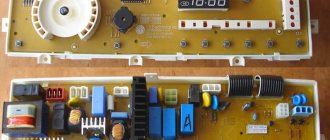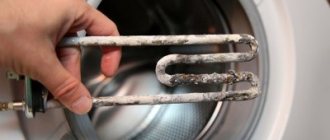Kandy washing machines are in demand, as the manufacturer offers an optimal balance of price and quality. However, any household appliance fails during active use.
Knowing which parts break most often and what signs indicate this, you will be able to overcome trouble that occurs at the most inopportune moment.
Read the article to get your Kandy washing machine repaired quickly and profitably.
What parts of the Candy washing machine break most often?
The Kandy washing machine has a complex structure; it consists of many parts. Most often, the main components that bear the main load fail . We are talking about a belt, a crosspiece, an electric heater, a hatch handle and more.
heating element
The heating element is the heating element of the washing machine. It comes into operation every time there is a wash in warm or hot water. The part is located under the drum.
Causes of failure and ways to eliminate them:
Voltage fluctuations in the network that lead to failure in electronics. You can deal with the problem by rebooting the device.- Hard water, which causes salt deposits on the electric heater. If the part is not burnt out, you can try to descale it and put it back in place.
- Oxides on contacts. They need to be cleaned.
- Damage associated with active and prolonged use of the machine. In this case, the heating element will have to be replaced.
Error codes indicating a breakdown of the heating element are 5, E5, E05, Err5, Error 5, or the same letters, but with the number 14, 16 or 22. Read more here.
Control board
The control board is the intelligence of the Kandy washing machine; it is responsible for executing all programs. The part is represented by a microcircuit, which is located in the upper part of the case .
The control board is susceptible to moisture and voltage surges. These reasons most often lead to the fact that either individual elements and tracks burn out, or a failure occurs in the firmware.
There are various signs indicating a board failure. The machine may not turn on at all, or will not execute one or more programs, jump from mode to mode, etc. Error codes – 14, E14, Err14, Error 14, or any other errors associated with performing a certain action.
The repair comes down to diagnosing the board, replacing burnt-out capacitors or triacs , and soldering the tracks. Sometimes flashing the memory and reprogramming the device is required. If the damage is serious, the board is replaced.
Water level sensor
A pressure switch is necessary so that the device can assess the degree of filling of the drum with water and perform further actions. If it breaks, the machine does not start the wash, the tank overflows or remains half empty.
Reasons for failure of the pressure switch:
- voltage surges leading to burning of wires;
- blockages in the pressure pipe;
- natural wear and tear.
To deal with the breakdown, you need to remove the part and check it for blockages. You should also eliminate minor damage, clean the contacts, and restart the machine. If these measures are ineffective, the pressure switch must be replaced.
Error code indicating a breakdown of the water level sensor is 2, E2, Err02, Error 2 or 20, E20, Err20, Error 20.
Cross
The cross is responsible for rotating the drum during washing . The part is subject to enormous loads, so over time it can break or bend.
A malfunction of the crosspiece is indicated by extraneous sounds that appear during washing and spinning. It may be rustling, knocking, grinding.
The only option to repair a broken or bent part is to replace it. There is no separate error code for a broken crosspiece. It is the same as the one that indicates bearing wear - 7, E7, E07, Err7, Error 7.
Causes of crosspiece failure:
- malfunction of the device,
- drum overload,
- bearing wear,
- hard water.
Belt
Without a belt, it is impossible to rotate the drum, since it is the belt that transmits the energy of the engine. If the belt falls off or breaks, a hum will be heard and the appliance will continue washing or spinning. However, the drum will remain in place.
Causes of failure and ways to eliminate them:
- The belt has stretched due to constant overload. It needs to be replaced.
- The belt falls off due to wear of the oil seal and bearings, or due to a burst crosspiece. There is no need to change it, you need to fix the main damage.
- The belt broke due to improper use of the device. Repair is not possible, replacement is required.
There are no error codes for belt breaks. A message may appear indicating that the bearings or motor are damaged. To diagnose the problem, just unscrew the case.
Hatch handle
The hatch handle serves for its safe and convenient opening. It is made of durable plastic, which is difficult to break. However, with the application of force, this is possible.
If a part is broken, it cannot be repaired . You'll have to buy a new pen. To perform the replacement, the door must be removed.
Possible error codes are 1, E1, E01, Err 1, Error 1. Although in most cases, no additional prompts are needed.
Pump or pump
The pump or pump is responsible for pumping water out of the drum and discharging it into the drain pipe . The part is located at the bottom of the device; you can access it after completely disassembling the washing machine.
The most common cause of failure is debris that gets into the part. Foreign objects either simply block the operation of the pump, or cause the impeller to break, or disable the motor, which is subject to excessive loads.
If the pump breaks down, the water will not drain or will leave the drum more slowly than usual. In this case, a code will appear on the screen - 3, E3, E03, Err3, Error 3, or similar letters, but with the number 20.
To eliminate the malfunction, the device must be disassembled, the pump removed and inspected. If a blockage is detected, the pump should be cleaned. A breakdown of the impeller or motor requires replacement of the part.
Engine
The motor is one of the main components of the Kandy washing machine. It is this that is the source of energy that sets the drum in motion. The most common reasons for its failure are short circuits . They can occur in the rotor and stater windings due to voltage surges, overloading of the washing machine, and even improper installation.
The main sign of a motor malfunction is the termination of any program. After diagnosing the breakdown, repairs are carried out. Most often, a complete engine replacement is required. Possible error codes are 8, E8, E08, Err 8, Error 8 or similar letter designations, but with the numbers 9 or 10.
Brushes
Brushes are necessary to transfer voltage from the stator to the rotor. They are made of graphite, so they wear out over time.
Worn brushes in Kandy washing machines are indicated by weak spin. If they are worn down too much, the drum will not rotate at all , since the motor will not have enough power. Sometimes sparks are visible under the machine.
There are no specific reasons leading to brush abrasion. This is a natural process that accelerates with active use of the device. The brushes cannot be repaired and must be replaced. Error codes indicating brush wear are 8, E8, E08, Err8, Error 8.
Bearing
The bearings allow the drum to rotate smoothly and silently . Its breakdown is indicated by loud sounds in the form of roaring and grinding. They intensify during spinning. If the bearings fail completely, the drum stops rotating.
The causes of failure are excessive loads on the elements, for example, when the machine is overfilled with laundry. An additional risk factor is moisture ingress. You need to understand that over time, even the best quality bearings break down. They cannot be repaired; the part must be replaced. Error codes indicating bearing failure are 7, E7, E07, Err7, Error 7. Details are in this article.
Shock absorbers
Shock absorbers or dampers are designed to dampen vibrations of the tank during spinning and washing. They work in conjunction with springs. Damage to the shock absorbers is indicated by strong vibrations and knocking noises during spinning. In this case, the device itself can “jump” and move from its place.
Reasons for their failure:
- drum overload,
- spin at high speeds,
- placing the device on an uneven surface,
- resource development.
Repair of shock absorbers is impossible; they must be replaced. There are no error codes indicating damage to the shock absorbers. To make a diagnosis, you will have to focus on external signs.
Read about repair and replacement of shock absorbers here.
Cuff
The elastic band located around the circumference of the hatch is a cuff. It helps the door close tightly and prevents leaks.
The most common reason for damage to its integrity is the carelessness of the owner of the washing machine, who leaves sharp objects in his pockets. It is they who cut the seal during the washing process.
The main sign of cuff damage is leakage . If the gap is minimal, you can seal it and turn the elastic band over so that the hole is on top. If there is significant damage to the integrity of the rubber band, it will have to be replaced. There is no error code, but in this case diagnosis is not difficult.
Drum
If the drum breaks down, it may stop rotating, when it moves, extraneous noise appears, and water begins to stagnate in it. Sometimes it begins to leak due to a hole, or becomes deformed. The main cause of the malfunction is violation of operating rules. Repair comes down to replacing a part. Error codes indicating problems with the drum are 10, E10, Err 10, Error 10.
Error E04 - when you can fix it yourself
Error 4 does not always indicate a breakdown. The water level sensor can detect overflow in the following situations.
- Adding water from the sewer due to a blockage. If the washing machine is connected to a siphon, then when it is clogged, the siphon overflows and water from it flows into the machine through the drain hose. In this case, the SMA can take in water even when it is turned off. To fix the problem, you need to clean the siphon.
- Adding water due to incorrect connection. The drain hose must be raised to a height of at least 60-100 cm from the floor. Otherwise, water from the sewer may enter the drum due to the siphon effect. Connect the SMA correctly (installation instructions are in the manual) or use a washing machine check valve if all else fails.
- Excessive foaming. A large amount of foam occurs due to excess powder, the use of unsuitable detergents (hand washing powder, low-quality products, etc.), as well as when washing porous items (tulle, down jackets, etc.). Depending on your situation, try reducing the amount of powder, changing the detergent, or washing “fluffy” items taking into account their specifics (on a delicate wash program, use less powder, etc.).
- One-time failure of the control module. Sometimes the control module freezes and issues a code incorrectly. Try unplugging the washing machine for 10-15 minutes. Perhaps this will clear the error and it will not happen again.
If none of the options described above are similar to yours, unfortunately, a breakdown has occurred.
Possible malfunctions of the Kandy washing machine
If a part breaks in a Kandy washing machine, this is manifested by a specific set of symptoms. For example, if the heating element breaks down, the water will not heat up, and if there is strong vibration, the device makes a lot of noise and vibrates during spinning. Knowing what malfunctions indicate, you can easily repair household appliances .
Doesn't heat water
When the washing machine does not heat the water, in 95% of cases this is due to a breakdown of the heating element. This can be confirmed by error codes - 5, E5, E05, Err5, Error 5. Less commonly, lack of heating indicates a malfunction of the pressure switch or control module. To find out the reason, you need to disassemble the device.
First, you should check the quality of fixation of the electric heater, as well as the integrity of its wires. If the part itself is broken, it must be replaced. The same algorithm is used to diagnose the water level sensor and controller.
The castle is on fire
The "lock" icon appears during washing . It signals that the washing machine is locked and it is impossible to open it until the cycle completes. In this case, no action needs to be taken.
If the “lock” is displayed after the end of the program and the machine cannot be opened, or it freezes, it is possible that the controller has malfunctioned. In this case, the device must be rebooted. Most often the problem goes away on its own.
Another reason for the “lock” to blink is when the child lock feature is activated . In this case, all buttons remain inactive even when pressed. It is enough to remove the blocking to solve the problem.
If the lock indicator flashes or lights up, but the hatch does not open or close, you should check the UBL. It may have failed and needs to be replaced. In this case, code 1, E1, E01, Err1, Error 1 will appear on the display.
Flowing
A washing machine leak never just happens. Water in the pan may appear due to the following reasons:
- the drain system is clogged - error code 3, E3, E03, Err3, Error 3, or similar letters, but with the number 20;
- the drain pipe has burst - the error codes are the same as for a blockage.
First, you need to disconnect the device from the power supply, and then check the pipe and pump for blockages and damage to integrity. If a breakthrough occurs, the part will have to be replaced.
Doesn't wring out
The reasons why the Kandy washing machine does not spin things out may be as follows:
- Spin is not provided for by the selected washing mode, or is simply disabled.
- There are too many things in the drum, causing its axis to shift. In top-loading washing machines, code 10, E10, Err10, Error 10 may appear.
- Due to a network outage, the control board malfunctioned. To deal with the problem, you need to restart the machine. Error codes – 14, E14, Err14, Error 14.
- The brushes, oil seal, crosspiece or bearings have exhausted their service life. They need to be replaced; repair is not possible. Error codes indicating bearing failure – 7, E7, E07, Err7, Error 7. Error codes indicating brush wear – 8, E8, E08, Err8, Error 8.
- Problems with the belt. It can stretch or fly off; to understand what happened, you need to assess its condition visually by twisting the back wall of the device.
- The tachogenerator is broken or is not sending signals correctly. Error codes – 17, E17, Err17, Error 17 or similar, but with the number 8. It cannot be repaired; you need to buy a new part.
- The shock absorbers have broken down. These parts cannot be repaired and will have to be replaced.
This publication will tell you why the Kandy washing machine does not spin clothes and what to do.
Freezes
If the Kandy washing machine freezes, this may be due to various reasons, including:
There is too much laundry in the drum, or it is bunched up. The weight control sensor stopped the operation of the device to prevent serious damage. If this is the case, some things need to be removed.- Drain and spin are disabled. In this case, the drum will stop along with the water. You need to check whether the selected mode is correct.
- The device is frozen and does not draw water. Most likely the pressure switch is broken. Error codes - 20, E20, Err20, Error 2.
- The machine does not work and does not heat the water. The most common cause of a malfunction is a breakdown of the heating element. Error codes: 5, E5, E05, Err5, Error 5, or the same letters, but with the number 14, 16 or 22.
- The tank remains motionless, the program is not executed, the machine is frozen. Most often this occurs due to a foreign object getting between the tank and the drum. The interfering part must be removed.
- Brush wear or motor failure. Brushes are consumables, you will have to purchase new components. You can try to repair the motor. Error codes indicating a breakdown of the motor and brushes: 8, E8, E08, Err 8, Error 8 or similar letter designations, but with the numbers 9 or 10.
- The control board is faulty. Perhaps its malfunction occurred due to a power surge. In this case, you can deal with the “freezing” of the washing machine by rebooting it. If the board breaks down, it needs to be repaired. Error codes – 14, E14, Err14, Error 14.
Doesn't turn on
If the Kandy washing machine does not turn on, it is necessary to exclude elementary reasons such as lack of electricity and a broken button that starts it up. A more complicated situation is a faulty control board.
When household appliances do not show any signs, most likely the module has completely failed and cannot be repaired. It will have to be replaced completely. Such repairs will be expensive for the owner of the device.
The machine may not turn on due to a faulty power cord or broken wires inside the device. They need to be found and replaced. Details are in this article.
Doesn't take up water
When the machine does not draw water, you should not immediately proceed to complex diagnostics. The water supply may have been cut off throughout the entire house. Sometimes the reason for its absence is even simpler - the supply hose is pinched by a foreign object, or the valve is closed. Fixing these problems will not be difficult.
More serious reasons why water will not fill the tank:
failure of the controller - in this case, the equipment needs to be rebooted;- there is a blockage in the area of the water supply valve - it needs to be cleaned;
- breakdown of the water level sensor - it cannot be repaired, it must be replaced, error codes - 2, E2, Err02, Error 2 or 20, E20, Err20, Error 20;
- failure of the UBL - in this case the door will remain open and water will not be drawn in, error codes - 1, E1, E01, Err1, Error 1.
Noisy
The strange noise that the machine makes during the spin cycle is most often associated with wear on the oil seal and bearings. If extraneous sounds are detected, you need to start diagnosing as soon as possible. Error codes indicating bearing failure are 7, E7, E07, Err7, Error 7.
Other, less common causes of extraneous noise:
- The machine is standing on an uneven floor. Correction of its position is required.
- The device is new, the wash was started with the transport bolts not removed.
- There is a foreign object in the drum.
- The bolts securing the counterweights have become loose.
Doesn't drain water
If the water remains in the machine after the wash cycle has completed, you need to wait a while. Sometimes the device simply processes the operation and after a few minutes the drain will start.
Provided that it was not possible to wait for the program to complete, several reasons should be considered:
- A blockage has formed in the area of the drain pump, or it has failed. In this case, a code will appear on the screen - 3, E3, E03, Err3, Error 3, or similar letters, but with the number 20.
- The drain hose is kinked or pinched.
- The pressure switch has failed. It needs to be twisted and checked for functionality. If a breakdown is detected, the part is replaced.
- The wires or contacts leading to the control board have come loose. They must be returned to their original position.
This publication will tell you why the Kandy washing machine does not drain water and what to do about it.
The door won't open
If the hatch cannot be opened after the end of the cycle, this may be due to several reasons:
- the control board is frozen because there was a power failure - a reboot is required to fix the problem;
- there is water in the appliance, which makes it impossible to open the door - most likely, the drainage system is faulty;
- The hatch locking device has failed.
The door may not open because the child lock is on. After turning it off, everything will return to normal. Read more here.
Jumps or vibrates strongly when spinning
If during a spin cycle the machine moves due to strong vibration, the reasons may be the following:
- The drum is overloaded with things. If this is indeed the case, the device must be stopped and some of the clothing removed.
- Installation on an uneven surface. To stop the device from vibrating, the leg needs to be adjusted.
- The counterweight screws have loosened.
- The shock absorbers are worn out.
- The bearings have exhausted their service life. Error codes indicating their failure are 7, E7, E07, Err7, Error 7.
How to reset?
Provided that the appearance of an error on the control panel of the washing machine is not caused by serious breakdowns, a reboot will help restore the operation of the household appliance.
If the washing machine signals a malfunction after starting the wash, you can reset the error by holding down the “Start/Pause” button for at least ten seconds (in some older models, the selector knob is additionally switched to the neutral position). The indicators on the control panel blinked green - the reset was successful.
If no indicator lights up or the error appears before the work cycle starts, you can fix the problem in the following way:
- Switch the selector handle to neutral position.
- Hold the Start/Pause button for five seconds.
- Unplug the household appliance, wait twenty minutes, and then reconnect the washing machine to the power supply.
If the washing machine does not respond to button presses and turns of the selector knob, abruptly unplugging the appliance from the outlet will help resolve the problem.
The emergency reboot method can be used only in exceptional, isolated cases, otherwise there is a high risk of control module breakdowns, which entails expensive, time-consuming repairs of household appliances.
Features of repair of equipment with vertical loading
Kandy top-loading washing machines have some differences in repair due to the location of parts:
- Such devices have a built-in drum parking sensor, which may fail.
- If the doors are opened during the washing process, this may cause the drum to jam. To fix the problem, you will have to completely disassemble the machine.
- The control board is located close to the top of the body, making it easier to access than with front-loading machines.
- If the drum leaks, the main components located under it may be damaged. Therefore, you need to ensure that foreign objects do not get inside.
Since the drum is located on top of the washing machine, overload cannot be allowed. Otherwise, repairs will be expensive.
Error E04 in Candy without screen
If your Kandy does not have a screen, it will indicate a problem with a series of flashes. The number of LED flashes will correspond to the code: that is, with error E04, you will see 4 blinks of the lights, followed by a pause and again 4 blinks. Various indicators may light up. It depends on the model of your washer. These are the lights that indicate an error in the Candy Grand, Smart, Holiday and Aquamatic line:
- Candy Grand. The code is reported using the light next to the “Intensive Wash” button (a shirt-shaped icon) and the first light on the left in the reverse time countdown system indication (usually the “90” indicator).
- Smart line. The signal lights are the light next to the “Intensive Wash” button (an icon in the shape of a shirt) and the top LED in the light indication of the reverse time countdown system (usually “90” or “Start”).
- Holiday and Aquamatic series. The code is displayed with the “Wash with cold water” indicator (with a snowflake icon).
How to disassemble a household appliance?
Analysis of SMA Kandi involves the following algorithm of action:
remove the top cover, which is secured with a pair of bolts from the back of the device;- get the powder receptacle;
- unscrew the water level sensor;
- remove the panel with buttons;
- carefully remove the counterweight, which is secured with bolts;
- disconnect the surge protector;
- turn off the filling valve;
- unscrew the back panel, remove the belt, disconnect the motor and heating element;
- using a screwdriver, unscrew the bolts securing the hatch - if there is no need to remove it, then leave the door on the front panel;
- disconnect the inlet hose;
- unscrew the counterweights;
- remove the tank from the shock absorbers and remove it.
The two halves of the tank are fixed with bolts; if necessary, they need to be unscrewed. This way the machine will be disassembled. Read more here.
Preparing for testing
Diagnostics of the Candy washing machine requires some preparation. First, you will need to use a digital ammeter with a measurement limit of 20 A/AC: it is connected in series to each power supply wire of the device. This will allow you to estimate the supply of electricity and estimate the current strength. If all electromechanical components comply with 220V parameters, you can proceed to the next step, namely releasing the washing machine drum.
The water should be drained from it and the laundry should be removed, since their presence in a household appliance can cause additional diagnostic errors. Now you need to set the programmer to the “OFF” position.
When should you change the hose?
If the drain hose is clogged with debris, hair, threads or other contaminants, it is not a reason to replace it . To restore passability, you just need to clean it with a stream of hot water. It will not be possible to do without replacing the hose if the blockage is formed by limescale. Removing it is problematic, and effective means for dissolving scale can damage the hose.
Another reason to buy a new hose is if it breaks. It will not be possible to seal the drain tube; it will still leak. Sometimes you have to purchase a new hose immediately after purchasing a washing machine, since it is not long enough.
Should I repair it myself or call a professional?
You can repair the washing machine yourself if the breakdown is simple, for example, the pressure switch has failed or the wires have come loose. In other cases, it is better to seek qualified help. You should also know what to do if the machine is still under warranty.
The machine is under warranty
The warranty period for Candy washing machines is 1 year . During this period, the manufacturer undertakes to eliminate all breakdowns at his own expense, but only on the condition that they were not caused by the owner of the household appliance himself.
To receive free service, you cannot attempt to set up the machine on your own. If specialists notice that the case has been opened, they will refuse to repair it.
Therefore, if you discover a manufacturing defect, you should immediately contact the retail outlet where the purchase was made or a branded service center. You must have a receipt with you, stamped with the date of purchase.
Do-it-yourself home repairs
Repairing at home is always convenient for the owner of household appliances, there are several reasons for this:
- The specialist will repair the only washing machine. It is in his interest to get the job done quickly.
- The user will not have to worry that some parts will be twisted and replaced with old ones. Everything happens before his eyes.
- The work will be paid only after the owner is convinced that the device is in working order.
- The machine has an impressive weight. When repairing at home, you do not have to take it to the workshop.
However, home repair has its disadvantages, namely:
- a scammer may be hiding behind a private ad;
- the technician will have to pay for the visit and diagnostics;
- the amount will be higher, since travel costs are already included in the cost of repair work;
- private craftsmen most often do not provide any guarantees.
To minimize the risk of meeting with an unscrupulous master, you need to read reviews about his work. If possible, it is better to contact those specialists who have already repaired household appliances for relatives or friends.
If a person values his reputation, he will not inflate prices, always provide receipts for replaced parts and will not inflate the cost of work.
Repair at the service center
Repairing a washing machine at a service center has several advantages:
All work is guaranteed for at least a year.- Spare parts will be replaced with originals, the user will not have to wait for their delivery. In large centers, components are always available.
- The risk of encountering scammers is minimal.
- Reputable organizations employ only professional craftsmen.
Among the disadvantages:
- You will have to transport the machine yourself to the service.
- Large workshops are loaded with orders, so the deadline for completing work may be delayed.
- The cost of work is higher than that of private owners.
If the choice falls on a service center, then you should contact a trusted organization that has been operating for many years. As a rule, such companies are well known in every city.
Our advantages
| Free departure on the day of order | We work every day, seven days a week | We work same day, evenings and weekends | We travel to any areas of Moscow and the Moscow region |
| We repair all brands of washing machines, even those over 15 years old | All masters are certified, Muscovites | Own warehouse of original spare parts, repairs are cheaper on average by 20% than competitors | Official guarantee up to 2 years |
